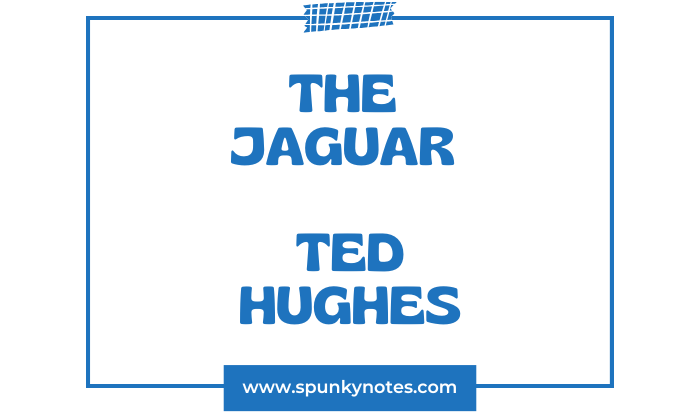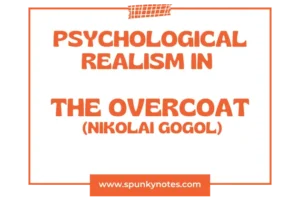

Estimated Reading Time: 14 min
The poem “The Jaguar” by Ted Hughes was published in his first poetry collection, The Hawk in the Rain, in 1957. This collection established Hughes as a powerful new voice in British poetry.
The Hawk in the Rain includes vivid poems about animals, nature, and raw instincts. Hughes’ intense language and imagery in this collection showcase his fascination with the wild.
Stanza 1
The apes yawn and adore their fleas in the sun.
The parrots shriek as if they were on fire, or strut
Like cheap tarts to attract the stroller with the nut.
Fatigued with indolence, tiger and lion
The apes yawn and adore their fleas in the sun.
Meanings
Yawn: to open one’s mouth wide, typically out of boredom or tiredness.
Adore: to focus on something with attention, almost as if showing affection or admiration.
Fleas: small, parasitic insects that often feed on the blood of animals.
Explanation
The apes are shown as lazy and bored, sitting in the sun with nothing to do but yawning and grooming themselves. They spend their time picking at fleas on their bodies, which reflects their boredom and lack of stimulation in the zoo.
The phrase “adore their fleas” shows the animals focusing on small, meaningless actions. This suggests that captivity has removed their natural interests. Without freedom, they turn to trivial things, losing excitement and purpose.
Instead of moving around or showing curiosity, they have become passive and lethargic, resigned to grooming themselves all day.
The parrots shriek as if they were on fire, or strut
Meanings
Shriek: a loud, high-pitched cry or scream, often showing urgency or distress.
As if they were on fire: a comparison suggesting they are making noise with intense, almost desperate energy.
Strut: to walk in a proud, exaggerated way, as if showing off.
Explanation
The parrots make loud, sharp cries, almost as if panicked. Hughes uses “as if they were on fire” to show their extreme calls as if they desperately want attention. Instead of flying, the parrots strut around like performers on display.
Their actions feel unnatural, hinting that they are performing for visitors rather than acting like wild birds. This line shows how captivity reduces the parrots to entertainers, making them act to please onlookers.
Like cheap tarts to attract the stroller with the nut.
Meanings
Cheap tarts: slang for showy performers who attract attention.
Stroller: here, it means a visitor or passerby casually walking by the cages.
Nut: a treat or snack, like food that visitors might throw to the animals.
Explanation
The parrots act like “cheap tarts,” trying to get attention with flashy behaviour. This comparison suggests that people see them not as wild birds but as performers.
The “stroller with the nut” refers to zoo visitors who pass by and throw food at the animals as a reward.
This line shows how captivity strips away the parrots’ dignity. Instead of being valued as wild creatures, they are reduced to amusing the crowd for treats.
Fatigued with indolence, tiger and lion
Meanings
Fatigued: extremely tired or worn out.
Indolence: laziness or being inactive; idleness.
Explanation
Hughes describes the tiger and lion, symbols of strength and grace, as “fatigued with indolence.” Here, they aren’t tired from activity but from forced inactivity.
In the wild, they would be energetic, roaming freely and hunting. However, the zoo has no space or chance for natural movement. This imposed laziness has made them sluggish and tired, showing how confinement drains their natural power.
Stanza 2
Lie still as the sun. The boa-constriktor’s coil
Is a fossil. Cage after cage seems empty, or
Stinks of sleepers from the breathing straw.
It might be painted on a nursery wall.
Lie still as the sun.
Meanings
Lie still: to stay completely motionless.
As the sun: a comparison to something that seems fixed and unmoving.
Explanation
Hughes intensifies the stillness of the tiger and lion by comparing them to the sun, which appears fixed in the sky. “still as the sun” simile shows animals so idle they seem lifeless.
The tiger and lion, usually full of strength and energy, now lie motionless, suggesting captivity has stripped them of their natural movement. This comparison shows how the zoo reduces wild animals to lifeless displays.
The boa-constrictor’s coil is a fossil.
Meanings
Boa-constrictor: a large snake known for coiling around and suffocating its prey.
Coil: the snake’s curled or looped body.
Fossil: a preserved remnant of a once-living thing, often turned to stone.
Explanation
It means the snake is so still that it seems almost lifeless, like something from long ago. Hughes uses “fossil” to suggest that the snake has lost its energy and strength. It’s like it has become a part of history, no longer active or alive in spirit.
Captivity has left it motionless, almost as if frozen in time, no longer active or powerful. The term “fossil” symbolizes how the snake’s natural life has become stagnant, making it seem more like a museum piece than a living creature.
Cage after cage seems empty, or stinks of sleepers from the breathing straw.
Meanings
Cage after cage: suggests a monotonous repetition of similar cages in the zoo.
Seems empty: appears lifeless or lacking activity. Stinks: gives off an unpleasant smell.
Sleepers: animals that are sleeping.
Breathing straw: straw that seems alive as animals breathe on it, filling the air with their scent.
Explanation
Hughes describes the cages as either empty or filled with the smell of sleeping animals. The phrase “cage after cage” creates a dull, repetitive image where all enclosures look the same, with no signs of active life.
The “stink of sleepers” emphasizes the stale atmosphere, as the only presence in the cages is that of animals lying on straw, breathing slowly.
The phrase “breathing straw” suggests that the straw in the cage absorbs the smell and warmth of the animals’ breath as they lie still.
It is as if the straw itself is alive, taking in the presence of the animals even while they rest motionless. This makes the scene feel heavy and filled with the animals’ scent, adding to the sense of inactivity in the cages.
This line paints the zoo as lifeless and monotonous, lacking the natural energy one would expect from wild creatures.
It might be painted on a nursery wall.
Meanings
Nursery wall: a wall in a child’s room, often decorated with animal pictures for a playful atmosphere.
Explanation
Hughes compares the lifeless zoo scene to a picture painted on a nursery wall, suggesting it is so dull and static that it might as well be a decoration.
The animals, confined and subdued, lack the vibrancy and wildness of real creatures. Instead, they appear as mere illustrations, lacking movement or life.
This comparison underscores how captivity strips animals of their essence, turning them into displays no more real or engaging than a child’s mural.
Stanza 3
But who runs llike the rest past these arrives
At a cage where the crowd stands, stares, mesmerized,
As a child at a dream, at a dream, at a jaguar hurrying enraged
Through prison darkness after the drills of his eyes
But who runs like the rest past these arrives
Meanings
Runs like the rest: moves quickly or indifferently, as others do.
Arrives: comes to a stop, reaching a destination.
Explanation
This line marks a shift in the poem’s focus. While earlier lines describe the lethargic animals and their lack of energy, here Hughes introduces someone (likely a zoo visitor) who is moving quickly past other cages.
Unlike others who simply stroll by without much interest, this person stops at one particular cage—the jaguar’s. This pause builds anticipation, suggesting a more exciting encounter.
At a cage where the crowd stands, stares, mesmerized
Meanings
Stands: to be stationary, fixed in place.
Stares: looks intensely with focus.
Mesmerized: completely captivated or entranced, as if under a spell.
Explanation
Hughes describes how the crowd gathers around the jaguar’s cage, thoroughly captivated by its presence. Unlike the other animals, the onlookers don’t pass by—they stop and stare, engrossed.
The word “mesmerized” suggests the jaguar has an intense, almost magical effect, holding them in awe. This description signals the jaguar’s power and energy, setting it apart from other animals.
As a child at a dream, at a jaguar hurrying enraged
Meanings
As a child at a dream: likens the crowd’s fascination to a child’s absorption in a dream.
Hurrying: moving quickly or urgently.
Enraged: extremely angry or filled with intense energy.
Explanation
Hughes compares the crowd’s focus on the jaguar to a child absorbed in a dream, evoking wonder and awe. Unlike the passive animals, the jaguar moves with energy and anger, “hurrying enraged.”
This line highlights the jaguar’s untamed spirit and fierce intensity, which remain undiminished by captivity.
Through prison darkness after the drills of his eyes
Meanings
Prison darkness: the gloomy, confined space of the cage.
Drills of his eyes: a focused, piercing gaze that seems like a tool or weapon cutting through darkness.
Explanation
The jaguar moves “through prison darkness,” hinting at the cage’s oppressive confinement. Despite this, its intense gaze, “the drills of his eyes,” pierces through the darkness, reflecting an undiminished spirit.
This powerful focus shows that the jaguar, unlike the other animals, won’t surrender to confinement’s limitations.
Stanza 4
On a short fierce fuse. Not in boredom —
The eye satisfied to be blind in fire,
By the bang of blood in the brain deaf the ear —
He spins from the bars, but there’s no cage to him
On a short fierce fuse. Not in boredom —
Meanings
Short fierce fuse: suggests intense, pent-up energy that could explode at any moment, like an explosive fuse.
Not in boredom: clarifies that the jaguar’s energy is not from boredom but something deeper.
Explanation
The jaguar is described as being “on a short fierce fuse,” with powerful energy that feels ready to erupt. This energy, contained but barely, hints at an intensity that could break free anytime.
Hughes contrasts this with other animals, which seem dull in their cages. The line “Not in boredom” clarifies that the jaguar’s pacing isn’t due to restlessness but intense, passionate energy, highlighting its wild spirit, unaffected by confinement.
The eye satisfied to be blind in fire
Meanings
Eye satisfied to be blind in fire: suggests the jaguar’s focused, intense gaze, almost blinding itself as if staring into flames.
Explanation
Hughes describes the jaguar’s eye as “satisfied to be blind in fire.” This shows the jaguar’s intense energy and focus. It suggests that the jaguar is so full of power and anger that it’s like he is staring into flames.
He doesn’t need to see anything else because his energy is so strong and consuming.
This focus is all-consuming, and the jaguar is almost blinded by its own passion. Unlike the other animals dulled by captivity, the jaguar’s inner fire remains, giving it a powerful quality.
By the bang of blood in the brain deaf the ear —
Meanings
Bang of blood in the brain: describes a pounding sensation of blood, suggesting adrenaline or heightened energy.
Deaf the ear: the intensity is so strong it drowns out other sounds.
Explanation
The jaguar feels the “bang of blood in the brain,” a pulse of intense energy. This line highlights the jaguar’s physical power, like a drumbeat drowning everything else out.
The phrase “deaf the ear” implies the jaguar is so absorbed in its own energy that it’s unaware of surrounding sounds, acting purely from raw instinct and force.
This rhythm shows the jaguar’s independence from its cage, which is connected deeply to its instincts.
He spins from the bars, but there’s no cage to him
Meanings
Spins from the bars: moves quickly away from the cage bars as if ignoring them.
No cage to him: suggests the jaguar doesn’t feel confined by the cage.
Explanation
The jaguar moves as if the cage around him isn’t there. Even though physically trapped, he behaves like he’s still in the wild. This line suggests that, in his mind, the jaguar doesn’t feel confined. His spirit stays free and powerful, untouched by the bars.
Its fierce energy and focus allow it to transcend the bars, symbolizing an unbreakable will and natural freedom. Hughes emphasizes the jaguar’s wild nature, as it doesn’t see itself as imprisoned, keeping its dignity and spirit intact despite captivity.
Stanza 5
More than to the visionary his cell:
His stride is wildernesses of freedom:
The world rolls under the long thrust of his heel,
Over the cage floor the horizons come.
More than to the visionary his cell:
Meanings
Visionary: a person with profound insight, imagination, or foresight, often seeing beyond ordinary understanding.
Cell: a small, confined space, often referring to a prison cell or small room.
Explanation
The jaguar is compared to a “visionary” who can mentally escape physical confinement. Just as a visionary’s mind can roam beyond the walls of a cell, the jaguar’s spirit seems to see beyond its cage.
The jaguar’s sense of freedom goes beyond that of a visionary. While a visionary can imagine freedom, the jaguar’s instincts keep it firmly connected to the wild. It doesn’t feel limited by the walls around it, as its spirit is unaffected by physical boundaries.
His stride is wildernesses of freedom:
Meanings
Stride: a long, purposeful step that shows confidence or strength.
Wildernesses: vast, wild, untamed natural areas that are unconfined and free.
Explanation
The phrase “wildernesses of freedom” expresses how the jaguar remains deeply connected to its natural instincts and wild nature, even though it is confined. It suggests that real freedom comes from within and does not rely on physical space.
The jaguar’s spirit is vast and unrestricted, as if it carries the open wilderness within each powerful step. This idea shows that, despite the cage, the jaguar’s inner self stays wild and free.
This line suggests that the jaguar’s freedom is internal; its powerful bond with the wild remains untouched by captivity.
The world rolls under the long thrust of his heel,
Meanings
Rolls under: gives the impression of moving beneath, as though the jaguar’s presence commands the ground itself.
Thrust: a strong, forceful push or movement indicating power.
Heel: the back part of the foot, symbolizing strength in each step.
Explanation
Hughes describes the jaguar’s steps as if the ground moves beneath him. This makes the jaguar seem so powerful that his presence affects everything around him.
Even though he is inside a cage, his strength seems so great that the earth responds to his movements. This image shows just how strong and commanding the jaguar is, and it appears he has control over his surroundings despite being confined.
The phrase “long thrust of his heel” highlights the strength and authority in each jaguar’s steps. It gives the impression that his power is so overwhelming that it almost seems as if he is making the ground shift beneath him.
This imagery suggests a commanding presence, making the jaguar appear larger than its confinement. Even within a cage, the jaguar exudes a sense of majesty and authority.
Over the cage floor the horizons come.
Meanings
Horizons: the line where the earth seems to meet the sky, symbolizing endless possibility or freedom.
Come: here, it suggests approaching or becoming visible, even within the confined space.
Explanation
Despite being in a cage, the jaguar mentally envisions “horizons” stretching beyond the cage floor. This line conveys the jaguar’s view of endless, open landscapes, symbolizing its connection to freedom.
Hughes suggests that the jaguar’s spirit remains vast and unbound as it imagines the wild horizons beyond the bars, reinforcing its resilient and untamed nature.


Excellant.I enjoyed the discussion very very much.Iam also very much grateful.